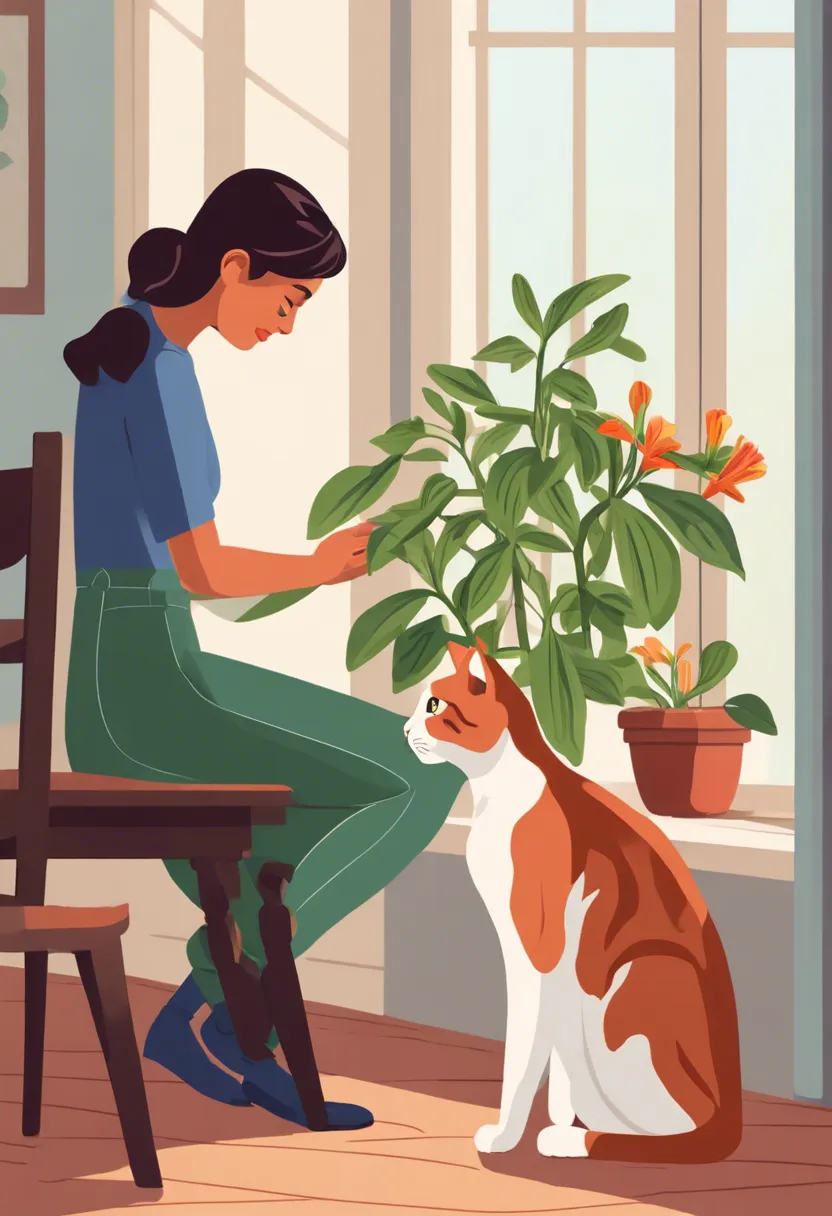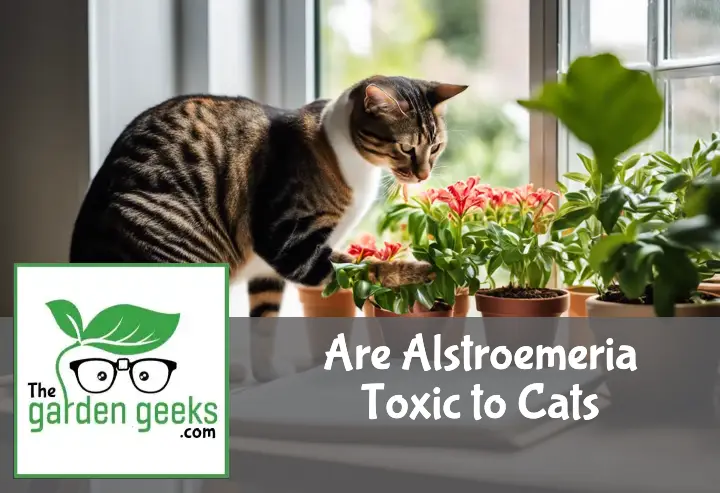Hello there, fellow feline aficionados! Ever found yourself pondering the question, “Are Alstroemeria Toxic to Cats?” Well, you’re not alone. It’s a common query among us cat parents, especially when we want to liven up our homes with some vibrant flora without putting our furry friends at risk.
In this post, we’ll delve into the nitty-gritty of Alstroemeria and their potential toxicity for our whiskered companions. So, buckle up and get ready for a fun, informative ride. Keep reading about “Are Alstroemeria Toxic to Cats?”
Key Takeaways
- Alstroemeria, also known as Peruvian lilies, are toxic to cats.
- The plant contains tulipalin A, a toxin that can cause vomiting, diarrhea, and other symptoms if ingested by cats.
- Even small amounts of the plant can be harmful to cats.
- Immediate veterinary care is recommended if a cat has ingested Alstroemeria.

What are Alstroemeria?
Alstroemeria, also known as the Peruvian lily or Inca lily, is a vibrant and eye-catching flower that’s a favorite in many gardens and floral arrangements. Their unique patterns and a wide range of colors make them stand out. Originating from South America, these flowers have found their way into hearts and homes around the globe, thanks to their beauty and versatility.
Origin and Description of Alstroemeria
Alstroemeria originates from the cool mountain regions of South America. Specifically, they’re native to Chile and Brazil, where they thrive in the wild. Known for their striking resemblance to miniature lilies, Alstroemerias boast intricate patterns on their petals, ranging from speckles to streaks, which add to their allure.
These flowers play a significant role in their native habitat, serving as an important source of nectar for pollinators. The Peruvian lily description wouldn’t be complete without mentioning its resilience; it can survive in both dry and cooler climates, making it quite versatile among flower species. Historical records suggest that the Incas valued these flowers not just for their beauty but also for their symbolic significance.
Common Uses of Alstroemeria
Today, Alstroemeria is celebrated worldwide for its use in floral design with Peruvian lilies taking center stage in many bouquets. Their long vase life makes them ideal candidates for floral arrangements, brightening homes with their vivid hues for days on end.
In gardens, these ornamental plants add splashes of color throughout spring and summer. Gardening enthusiasts appreciate gardening with Alstroemeria because they’re relatively easy to care for with the right cut flower care tips. Beyond personal enjoyment, these flowers often carry cultural significance at events and ceremonies, symbolizing friendship and mutual support among other meanings.
Are Alstroemeria Toxic to Cats?
So, you’ve got a furry feline friend and a love for beautiful blooms, huh? Well, let’s dive into the nitty-gritty of Are Alstroemeria Toxic to Cats and keep both your kitty and your green thumb happy.
Understanding Cat’s Interaction with Plants
Cats and plants. It’s like they’re drawn to each other by some mysterious force. Maybe it’s the rustling leaves or the intriguing textures, but cats just can’t seem to stay away from greenery. This natural curiosity often leads them to nibble on whatever plant catches their eye, including Alstroemeria.
Now, not all plants are a no-go for our whiskered pals. However, when it comes to preventing cat-plant interactions, knowing which ones are safe is key. After all, understanding cat behavior is the first step in keeping them out of harm’s way.
The Toxic Components in Alstroemeria
Alrighty, let’s get down to brass tacks. What exactly makes Alstroemeria a concern for our purring pals? It boils down to certain toxic substances found within these pretty petals. One of the main culprits is lycorine—a compound that doesn’t play nice with cats.
Lycorine toxicity in pets isn’t something to take lightly. It can cause all sorts of unpleasantness for your feline friend. That’s why identifying poisonous plants and pet poison prevention tips are crucial for any pet parent looking to maintain a pet-safe houseplant collection.
Effects of Alstroemeria on Cats
So what happens if your curious kitty decides that an Alstroemeria looks tasty? Well, the symptoms of plant toxicity in cats can range from mild irritations to more severe health issues. We’re talking vomiting, diarrhea, or even more serious signs that scream “vet visit ASAP.”
If you ever find yourself in this situation—seeing signs of toxicosis in your feline—speed is essential. Treating Alstroemeria exposure promptly can make all the difference. Always have your vet’s number handy because when it comes to emergency care for a poisoned cat, every moment counts.



How to Recognize Symptoms of Alstroemeria Poisoning in Cats?


Spotting the signs early can be a game-changer when it comes to Alstroemeria cat toxicity. It’s all about keeping an eye out for those tell-tale symptoms and rushing to get help if you spot trouble.
Physical Symptoms
If your feline friend starts showing signs like cat vomiting or skin irritation, it might be more than just a bad day. These are classic red flags of Alstroemeria allergic reaction. Don’t just brush it off as something they ate; these symptoms scream for immediate vet attention.
Another thing to watch out for is diarrhea or excessive drooling. It’s not just gross; it’s a sign that your kitty could be dealing with some serious toxic plants for cats. Remember, these physical symptoms don’t just make for a rough day for your cat—they’re urgent cries for help.
Behavioral Changes
Now, let’s talk mood swings. If your usually lazy furball suddenly turns into Mr. Grumpy Pants or seems more tired than usual, take note. This could be a sign of cat lethargy causes linked to poisoning. And if Fluffy is suddenly picking fights or avoiding cuddles, this aggression could point towards discomfort or pain from exposure to toxic substances.
It’s crucial to keep an eye on these behavioral shifts. They might seem minor, but they can be the first clue that something’s up with your pet’s health—especially if they’ve been nosing around houseplants recently.
What to Do if Your Cat Ingests Alstroemeria?
Discovering your cat has nibbled on some Alstroemeria can be a real “oh no” moment. But don’t panic! There are steps you can take to ensure your furry friend stays safe.
Immediate Steps to Take
First things first, keep calm. Your kitty needs you to be their hero right now, not a headless chicken running around. Gently remove any plant material from your cat’s mouth and ensure the Alstroemeria is out of reach. If you suspect cat ingested Alstroemeria, acting quickly is key but never try inducing vomiting without consulting a vet first—it can do more harm than good. Instead, giving activated charcoal for cats might be recommended by your vet over the phone as it helps prevent toxin absorption. Meanwhile, make sure your cat has access to plenty of water to stay hydrated.
When to Consult a Vet
Now, if Fluffy starts showing any weird signs like drooling more than an overheating car or suddenly acting as if they’ve lost their last life in a video game, it’s time for professional help. Signs of severe toxicity in cats such as vomiting, diarrhea, lethargy, or anything out of the ordinary should have you dialing the vet faster than you can say “emergency.” Before rushing off, grab any evidence of the plant ingestion—yes, those chewed up leaves count—and any details about when it happened. This info is gold dust for vets and helps them give the best possible care. Remember, emergency care for cats after Alstroemeria ingestion isn’t just about getting them seen; it’s about being prepared with all the right info too.
Preventive Measures for Protecting Cats from Alstroemeria
Worried about your furry friend munching on something they shouldn’t? Are Alstroemeria Toxic to Cats? Absolutely, but don’t fret! There are plenty of ways to keep them safe and sound.
Safe Alternatives to Alstroemeria for Cat Owners
Switching out Alstroemeria for some non-toxic plants for cats is like swapping your regular latte for a decaf – all the joy without the worry. Consider adding some safe houseplants cat owners can proudly display, like spider plants or Boston ferns. These green beauties are not only safe but also add a touch of nature’s charm to any room. Plus, they’re pretty easy on the eyes and won’t tempt fate or whiskers. For those with a floral fancy, why not opt for pet-safe indoor flowers such as roses or orchids? They’re like the superheroes of the plant world for cat owners – stunning, safe, and totally cat-friendly gardening goals.
Tips for Keeping Cats Away from Harmful Plants
First off, getting physical barriers might sound a bit spy-movie-esque, but it’s just about putting up some strategic defenses. Think baby gates or plant shelves that turn your toxic greenery into untouchable treasures. Next up, ever thought about using natural deterrents for cats? Citrus peels or coffee grounds sprinkled around your plants can work wonders because let’s face it – no cat’s dream dinner smells like lemon zest or espresso shots. And if you’re into techy stuff, motion-activated sprays can gently remind your kitty that some gardens are meant to be admired from afar. Remember, it’s all about keeping cats safe from plants, not turning your home into Fort Knox!


To Wrap Up
In the feline world, curiosity isn’t just about killing the cat; it’s also about making them sick. So, to answer your burning question: “Are Alstroemeria Toxic to Cats”? Yes, they are.
So next time you’re picking out a bouquet, think of your cat as a toddler with paws—always exploring but not always knowing what’s best for them. Choose pet-friendly flora instead!


